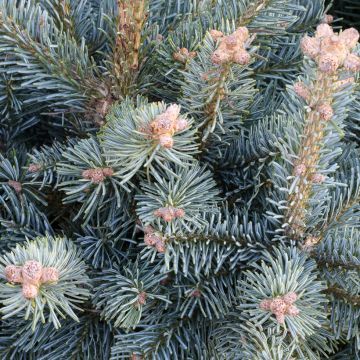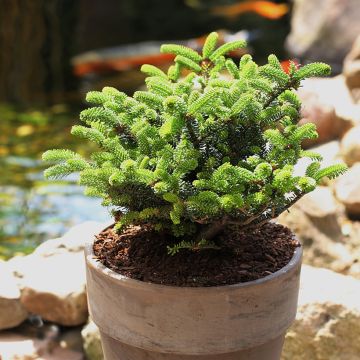

Sapin de Corée - Abies koreana Samling
Abies koreana Samling - Korean Fir
Abies koreana Samling
Korean Fir
Special offer!
Receive a €20 voucher for any order over €90 (excluding delivery costs, credit notes, and plastic-free options)!
1- Add your favorite plants to your cart.
2- Once you have reached €90, confirm your order (you can even choose the delivery date!).
3- As soon as your order is shipped, you will receive an email containing your voucher code, valid for 3 months (90 days).
Your voucher is unique and can only be used once, for any order with a minimum value of €20, excluding delivery costs.
Can be combined with other current offers, non-divisible and non-refundable.
Why not try an alternative variety in stock?
View all →This plant carries a 24 months recovery warranty
More information
We guarantee the quality of our plants for a full growing cycle, and will replace at our expense any plant that fails to recover under normal climatic and planting conditions.
Would this plant suit my garden?
Set up your Plantfit profile →
Description
Abies koreana 'Samling' is a variety of Korean fir with small size and slow growth that has a typical fir habit, pyramidal and regular, very dense. Its foliage consists of short, shiny, non-prickly needles, bright green on the top, showing 2 white lines on the underside. In spring, its light green shoots come alive with purple buds that develop into upright cones of a beautiful size, also purple. This variety is well suited for ornamental use in small gardens. The Korean fir likes moist, fertile, well-drained, sandy or loamy, non-chalky soils.
The Korean fir, Abies koreana, is a conifer of the pinaceae family native to the mountains of southern Korea. This small conifer reaches a height of 6 to 9 m (20 to 29ft) in its natural environment and has a compact habit. The 'Samling' variety grows very slowly, with a growth rate of about 3 to 5 cm (1 to 2in) per year. Ultimately, the plant measures approximately 5 m (16ft) in height and 3 m (10ft) in width. This fir tree develops numerous branches arranged in dense tiers. Flat, very fine and flexible soft needles, shiny on top and measuring 2-3 cm (1in), grow on its branches. Its velvety spring buds contrast with its bright green foliage, and beautiful upright purple cones, reaching a height of 7 cm (3in), appear on mature specimens.
Abies koreana 'Samling' can be placed alone or in groups of 3, on a lawn or in a large rockery. Its perfect fir tree silhouette fits well with contemporary or more classic decorations. The architectural qualities of dwarf conifers deserve to be invited more often into our gardens, as they provide a permanent structure. These are rather discreet plants in summer and stand out again in winter, when flowering is rare. They mark pathways, border terraces, and adorn the corner of a large shrub border. To accompany the Korean fir 'Samling', choose, for example, a ground cover conifer like Juniperus Blue Carpet, or a variety that forms a ball like Pinus mugo Varella. Grasses complement conifers very well with their form. Think of Stipa tenuifolia, Pennisetum Hameln Gold, or Miscanthus Aperitiv, for example.
Report an error about the product description
Plant habit
Flowering
Foliage
Botanical data
Abies
koreana
Samling
Pinaceae
Korean Fir
Cultivar or hybrid
Other Abies
View all →Planting and care
Plant Abies koreana 'Samling' from September to November or from February to May, in well-drained soil, enriched with compost, that won't dry out too much in summer, in full sun or partial shade. This species is sensitive to heat and strong sunlight and does not tolerate limestone. Water the young plants regularly during the two to three summers following planting. The Korean fir should be watered during prolonged periods of high heat. This bush does not require pruning, but any unsightly or obstructive branches can be removed to enhance its attractive shape.
Planting period
Intended location
Care
This item has not been reviewed yet - be the first to leave a review about it.
Similar products
Haven't found what you were looking for?
Hardiness is the lowest winter temperature a plant can endure without suffering serious damage or even dying. However, hardiness is affected by location (a sheltered area, such as a patio), protection (winter cover) and soil type (hardiness is improved by well-drained soil).

Photo Sharing Terms & Conditions
In order to encourage gardeners to interact and share their experiences, Promesse de fleurs offers various media enabling content to be uploaded onto its Site - in particular via the ‘Photo sharing’ module.
The User agrees to refrain from:
- Posting any content that is illegal, prejudicial, insulting, racist, inciteful to hatred, revisionist, contrary to public decency, that infringes on privacy or on the privacy rights of third parties, in particular the publicity rights of persons and goods, intellectual property rights, or the right to privacy.
- Submitting content on behalf of a third party;
- Impersonate the identity of a third party and/or publish any personal information about a third party;
In general, the User undertakes to refrain from any unethical behaviour.
All Content (in particular text, comments, files, images, photos, videos, creative works, etc.), which may be subject to property or intellectual property rights, image or other private rights, shall remain the property of the User, subject to the limited rights granted by the terms of the licence granted by Promesse de fleurs as stated below. Users are at liberty to publish or not to publish such Content on the Site, notably via the ‘Photo Sharing’ facility, and accept that this Content shall be made public and freely accessible, notably on the Internet.
Users further acknowledge, undertake to have ,and guarantee that they hold all necessary rights and permissions to publish such material on the Site, in particular with regard to the legislation in force pertaining to any privacy, property, intellectual property, image, or contractual rights, or rights of any other nature. By publishing such Content on the Site, Users acknowledge accepting full liability as publishers of the Content within the meaning of the law, and grant Promesse de fleurs, free of charge, an inclusive, worldwide licence for the said Content for the entire duration of its publication, including all reproduction, representation, up/downloading, displaying, performing, transmission, and storage rights.
Users also grant permission for their name to be linked to the Content and accept that this link may not always be made available.
By engaging in posting material, Users consent to their Content becoming automatically accessible on the Internet, in particular on other sites and/or blogs and/or web pages of the Promesse de fleurs site, including in particular social pages and the Promesse de fleurs catalogue.
Users may secure the removal of entrusted content free of charge by issuing a simple request via our contact form.
The flowering period indicated on our website applies to countries and regions located in USDA zone 8 (France, the United Kingdom, Ireland, the Netherlands, etc.)
It will vary according to where you live:
- In zones 9 to 10 (Italy, Spain, Greece, etc.), flowering will occur about 2 to 4 weeks earlier.
- In zones 6 to 7 (Germany, Poland, Slovenia, and lower mountainous regions), flowering will be delayed by 2 to 3 weeks.
- In zone 5 (Central Europe, Scandinavia), blooming will be delayed by 3 to 5 weeks.
In temperate climates, pruning of spring-flowering shrubs (forsythia, spireas, etc.) should be done just after flowering.
Pruning of summer-flowering shrubs (Indian Lilac, Perovskia, etc.) can be done in winter or spring.
In cold regions as well as with frost-sensitive plants, avoid pruning too early when severe frosts may still occur.
The planting period indicated on our website applies to countries and regions located in USDA zone 8 (France, United Kingdom, Ireland, Netherlands).
It will vary according to where you live:
- In Mediterranean zones (Marseille, Madrid, Milan, etc.), autumn and winter are the best planting periods.
- In continental zones (Strasbourg, Munich, Vienna, etc.), delay planting by 2 to 3 weeks in spring and bring it forward by 2 to 4 weeks in autumn.
- In mountainous regions (the Alps, Pyrenees, Carpathians, etc.), it is best to plant in late spring (May-June) or late summer (August-September).
The harvesting period indicated on our website applies to countries and regions in USDA zone 8 (France, England, Ireland, the Netherlands).
In colder areas (Scandinavia, Poland, Austria...) fruit and vegetable harvests are likely to be delayed by 3-4 weeks.
In warmer areas (Italy, Spain, Greece, etc.), harvesting will probably take place earlier, depending on weather conditions.
The sowing periods indicated on our website apply to countries and regions within USDA Zone 8 (France, UK, Ireland, Netherlands).
In colder areas (Scandinavia, Poland, Austria...), delay any outdoor sowing by 3-4 weeks, or sow under glass.
In warmer climes (Italy, Spain, Greece, etc.), bring outdoor sowing forward by a few weeks.















































